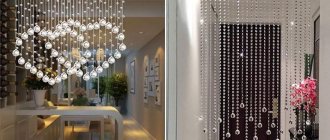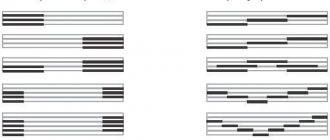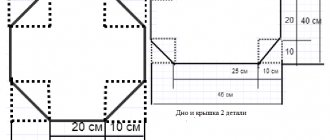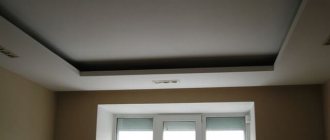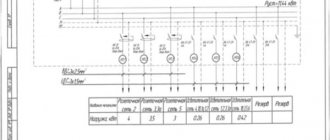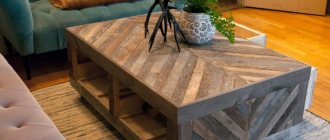Roman blinds are simple, elegant and functional. They combine the advantages of curtains and horizontal blinds and are suitable for kitchens and rooms decorated in classical and Japanese styles, country, art deco, modern, etc., as well as for loggias and bathrooms as a means of protection from prying eyes and sunlight. Using step-by-step instructions, you can sew Roman blinds with your own hands, providing them with a convenient lifting mechanism.
How to sew Roman blinds with your own hands
When raised, the curtain gathers into beautiful folds. To understand the principle of sewing and operation of a lifting structure, it is better to start with a product for a small window. You need to depict your idea in a sketch (after measurements) and provide for fastening the curtain in such a way that it does not interfere with the opening of the window.
Cascading structures look voluminous, gathered into folds even in an unfolded position, so they are difficult to manufacture. For beginners, the classic model is more suitable.
It uses slats that are evenly distributed over the canvas at a distance of 25-30 cm. When lifted, identical strict horizontal folds are formed. Their number depends on the height of the window and the length of the product.
What are Roman curtains?
Curtains made based on the sails of a ship of the ancient Romans are called Roman in the modern world. They have a fairly simple mechanism of action - they lower/raise quickly and efficiently.
Roman blinds have a fairly simple mechanism of action - they are quickly and efficiently lowered/raised
Modern Roman blinds have the following characteristics:
- have a stylish design;
Roman blinds hide the penetration of bright sunlight well
- hide the penetration of bright sunlight well;
- easy to use;
Roman blinds have a stylish design
- moderately strict, but at the same time elegant;
- have an original appearance.
In addition, if you make Roman blinds with your own hands, you will need much less fabric as for other curtains.
Roman curtains are sheets of material in which for every twenty to thirty centimeters of fabric there are horizontal strips that create folds when the structure is raised. In order for such a curtain to hold well and not sway from the slightest breeze, a small weighting material is attached below.
Roman blinds have an original appearance
The mechanism of operation of such curtains is quite simple - you just need to pull the attached control cord and the curtain opens or closes. This control mechanism consists of several cords, which are located along the edges of the curtain in special ring holes.
On a note! Roman blinds are an ideal option for rooms of any functionality: kitchen, living room, bedroom or children's room.
How to take measurements and pattern correctly
To make a pattern, you need to determine the height and width of the finished product.
Measurements are taken depending on the installation of the curtain:
- When installing windows in an opening, the width of the upper part of the opening and its height (to the window sill) are determined. To ensure that the curtain fits well into the opening, subtract 2 cm from the results obtained.
- For rooms with a standard ceiling height, install the product to the ceiling. The length of the curtain is equal to the distance from the ceiling to the floor, the window sill minus 2 cm, and the width is 10-20 cm greater than the width of the opening.
- When attaching to the wall above the window, add 10-20 cm to the width of the opening and its height. The side allowances will cover the slopes. The assembled curtain will not interfere with opening the window.
- When installing on plastic windows, measure the distance between the inner edges of the frames.
To prevent the finished curtain from shrinking after washing, the fabric must be soaked in warm water, dried and ironed before cutting.
When cutting the canvas, the following allowances are made:
- 5-6 cm – on the side cuts (2.5-3 cm on each side);
- 3 cm - for the hem of the bottom;
- 2-3 cm – for the top part.
Curtains are sewn double (or lined) and single (usually made of transparent fabric).
How to attach a cornice
Cornices for Roman blinds are attached to the wall above the window, under the ceiling or into the window opening itself. The choice depends on which window needs to be closed and what purpose its owner is pursuing:
- The main advantage of mounting under the ceiling is the visual increase in height of the window opening. This option is perfect for low rooms. Also, a curtain hanging directly from the ceiling will cover part of the wall above the window, which can serve as an additional decorative element.
- Installation in a window opening will save space and provide constant access to the window sill. In addition, this option is convenient if Roman curtains are used in conjunction with ordinary curtains.
- There are two ways to attach a cornice to a wall. The first involves installation perpendicular to the wall (on the edge) using metal corners. In this case, the curtain will be located at a certain distance from the window opening (corresponding to the width of the cornice). Typically, this option is chosen when there is a wide window sill.
- The second method of fastening is parallel, that is, the cornice is screwed flat to the wall. This way the curtain will be closer to the window, which is convenient if the window sill is narrow. This mounting option can also be combined with regular curtains.
You may also be interested in: How to sew a curtain for the living room with your own hands - instructions
Once the method of installing the cornice has been chosen, you can begin to manufacture it.
Which fabric is better to choose
Roman curtains are made from different fabrics:
- light - tulle, silk, cambric, muslin;
- medium - linen, calico, satin, calico;
- heavy - velvet, velor, tapestry.
Artificial and mixed fabrics are considered the most practical: they are easier to wash and iron. It is better to choose materials intended for curtains, because... they are more resistant to fading.
A Roman blind requires a little fabric - 3-5 times less than classic curtains. Therefore, exquisite expensive material is often used to sew it. The flowability of the fabric does not matter, because... the sections are processed.
It is important that the pattern and color of the canvas match the overall design style of the room. For example, a checkered pattern and cheerful floral motifs would be appropriate for a kitchen in country and Provence style, while plain, simple ones without decor would be appropriate for an office. It is better to sew the first curtain from thick fabric: it is easier to work with.
Fabric selection
To make Romanesque curtains yourself, you should initially choose the right fabric. There are many options for color, print, density, composition, manufacturing principle and price. You can easily cope with the choice if you take into account several nuances:
- The degree of shading that should be chosen in accordance with the illumination of the windows. If the windows face the sunny side, then a fabric with a Black out effect would be an ideal option. Translucent fabrics are suitable for rooms with normal lighting. It is better to equip dark rooms with curtains made of the thinnest and most transparent fabric.
- Much depends on where the curtain will be placed in the future. In technical rooms, you can use sheets made of cheap textiles or covered with oilcloth. For bedrooms and hallways, textile bases made from expensive and natural fibers would be an ideal option.
- Synthetic fabrics for Romanesque curtains are a separate category of material that is used for certain categories of products.
You might be interested in this: Making patterns and sewing school aprons for the last bell
Please note! When choosing a material for bathrooms, you should pay attention to options with special impregnations of the fabric base.
Fabric selection
Colors and prints should match the color scheme of the room's interior. The sizes of the canvases are also selected individually.
Synthetic fabrics for Roman blinds
Most often, synthetic fabrics for Roman blinds are used for arranging kitchen windows. Such material can be replaced if necessary, and it will not be too expensive. It is much easier to wash and clean various stains from a synthetic fabric than from a natural base.
What you need for sewing
For sewing you need:
- fabric, if necessary - material for lining and elements for decoration;
- a ready-made complete set of curtain rods for Roman blinds of the required length, closed or open (it includes a lifting block, strips, weighting material, chains, rings, threads, screws for fastening, etc.);
- Velcro tape along the width of the curtain;
- braid (preferably transparent);
- sewing machine.
You can put together a kit for the cornice yourself (it will cost much less).
Required accessories:
- nylon cord with a length equal to 6 times the length of the curtain and its triple width (it must be cut into 3 equal parts);
- drawstring tape;
- plastic rings with a diameter of 10-12 mm - for drawstrings (cords are threaded through them to lift the fabric);
- rods made of fiberglass, wood or wire;
- weighting material - a wooden or plastic strip 2.5 cm wide;
- bar for hanging curtains;
- small nails.
Curtain design
What is a Roman blind? This is a rectangular fabric, divided horizontally by drawstrings. Rigid rods are inserted into them, which help form even folds on the curtain. Rings are sewn to the edge of the fold, through which ribbons or ropes are threaded to lift the fabric.
Folded Roman blinds
A plastic strip is attached at the bottom of the curtain, which acts as a weighting agent. It is inserted into the folded edge or fixed on hinges.
On the side, the Roman blind can be free or attached to the guides. It is very convenient to use it if the kitchen has roof windows.
Step by Step Actions
Master class on sewing single-layer Roman blinds with photographs:
- Fold the side allowances inside out twice and stitch at a distance of 1-1.3 cm from the edge.
- Fold the bottom seam allowance (if the factory edge of the fabric was not cut off, 1 fold is enough) and stitch. A weighting agent will be inserted into the resulting drawstring.
- Make a control measurement of the length of the curtain. Turn the top seam allowance to the wrong side. Not reaching 1-2 mm from the top edge and sides, pin the soft part of the adhesive tape and stitch it.
- On the wrong side of the fabric, mark the lines for the location of the strips or rods, taking into account their width. If there are 4 slats included with the cornice, there will be 5 folds.
- Divide the braid into segments according to the number of strips. The length of each should exceed the width of the curtain by 2 cm. Sew the braid along the marked horizontal lines. Tuck the cuts by 1 cm and do not attach them (the strips will be inserted into the holes).
- Sew rings on all pieces of braid and on the pocket for the weighting material at a distance of 12-20 cm from the sides. A cord will pass through them to raise and lower the curtains.
- Install cord guides on the cornice - above the rings.
- Attach the curtain to the curtain rod by connecting both parts of the adhesive tape (one of them is sewn to the curtain, the other is glued to the curtain rod).
- Thread the pieces of cord through the rings vertically to the top. Bring them to one side. Attach the cords to the lower rings with knots. Make sure they are tensioned equally. Tie the cords at the level of the eaves with a knot, and intertwine the hanging ends together.
- Insert weight material and strips.
- Install the fasteners on the cornice, mark their locations on the frame, wall or ceiling.
How to hang a curtain
Once the curtain rod is attached to the wall, all that remains is to hang the Roman shade. You need to decide whether the tension cord will be on the left or right. On the opposite side, fasten the rope to the bottom ring of the vertical row, pass it through the entire row of rings and through the pins screwed to the cornice. The free end of the rope should be approximately 3/4 of the length of the curtain. Next, fasten and stretch the 2nd rope through the 2nd row of rings and pins and so on.
Attach the curtain to the curtain rod. Align the length of all ropes. Make sure their tension is the same. Tie them all behind the last pin and weave them into 1 cord.
You may also be interested in: How to sew roller blinds with your own hands - instructions with photos
Pull the resulting cord, the curtain will rise in folds. To secure it, attach a hook to the wall and wrap the cord around it when raising the curtain.
Save
Nuances in tailoring
When sewing you need to consider:
- Paper patterns for Roman blinds are not made.
- The fabric and braid should be smooth.
- To apply marks and lines, the fabric is laid out on a flat, smooth surface.
- Horizontal stitches should not tighten the sides, and vertical stitches should not tighten the edges of the product. To do this, you need to adjust the thread tension of the sewing machine.
- It is important to carefully combine the details.
- The soft part of the Velcro tape is attached to the curtain, the hard part is attached to the curtain rod.
- You need to attach the braid in one direction, otherwise the fabric will curl between the lines.
- For those who do not have sewing skills, it is better to choose a variegated or small-checked fabric: possible flaws are less noticeable on it.
- To secure the control mechanism rings, strong nylon threads are used that can withstand constant stress.
Depending on the width of the curtains, you can sew 2-5 rings in a row and the same number of cords to lift them. Each is tied to the bottom ring, threaded through all the rings in the vertical row, and then horizontally (through rings or pins), bringing the ends together.
DIY cornice construction
You can make a beautiful and durable cornice yourself from simple materials.
For this you will need:
- a board 4 cm wide, up to 2 cm thick, and a length equal to the width of the curtain (for fastening inside the opening, take a thinner board);
- a piece of fabric is 2.5-3 cm wider than the board and 7.5-8 cm longer (it needs to be ironed);
- Velcro tape - along the width of the curtain;
- stapler;
- pins (ears) according to the number of vertical rows of rings on the curtain;
- corners for attaching cornices.
A curtain heavier than 3.5-4 kg will not be held on with Velcro (Velcro tape). It is nailed to the cornice with small nails.
Cornice manufacturing technology with photo:
- Cover the board with fabric. First, wrap the long sections, secure them with staples at a distance of 15-20 cm, then the side ones.
- Attach the rigid part of the Velcro tape to the wide part of the cornice with a stapler.
- Attach the curtain to the curtain rod and mark on it the locations of the rings in the row. Remove the curtain and screw in the pins according to the markings.
- Screw the corners at least 2 cm from the edges.
How to make Roman blinds from old blinds
Old blinds with a working lifting mechanism will do (the condition of the rotating device and slats does not matter). You will also need fabric and weighting material. A thin plastic or metal lamella will not work as it, because... its too light weight will not create enough tension for the cords when lifting.
You need to cut 1 thread on both sides: they will regulate the rotation of the plates; Untie the second pair of threads at the bottom and disassemble the blinds into individual elements. Of these, the top strip (as a cornice) and slats (instead of rods) will be used for the curtain.
The next steps are the same as for making a single layer curtain. If the fabric is transparent, the slats can be painted in a suitable color.
Roman blinds for wide windows
A simple curtain cannot decorate a wide window. In this case, a Roman blind consisting of several parts would be an ideal option. There are two simple options for this design.
Wide windows
The “skeleton” may be the first one, but several canvases are attached to it. Moreover, each part will be completely autonomous from the others. Or you can make separate structures that will be mounted at the same level.
You may be interested in: Rules for sewing pillows for a pregnant woman yourself
Decor for the top and bottom edges
The upper part of the curtains is decorated with lambrequins (ribbon, modular and lace), appliques, compositions of rhinestones and sequins.
To finish the lower edge, decorative elements such as:
- satin ribbons - along the contour, at a distance of 15-25 cm from the edges or in the form of bows;
- lace;
- figured fringe;
- lush ruffle;
- beaded scallops;
- bugles;
- braid and fringe;
- straight ruffles;
- butterflies;
- beads;
- rivets;
- buttons.


